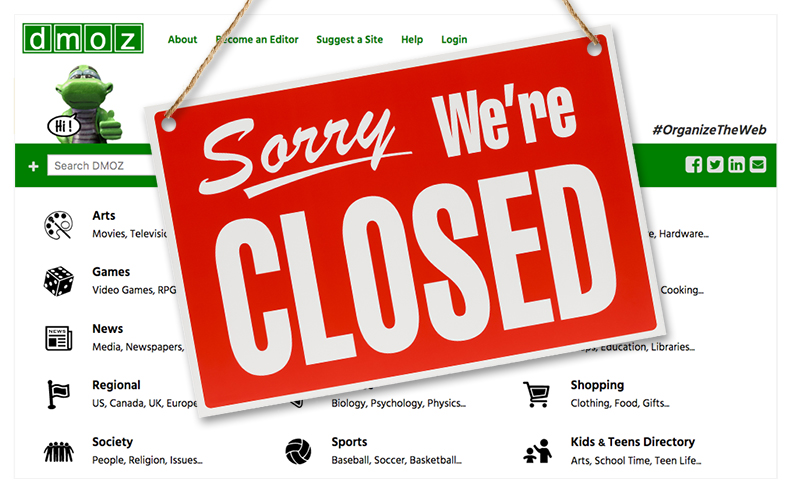Local SEO Tips – Citation Building in 2017
LOCAL SEO and CITATION BUILDING in 2017
Citations still play a critical role in local ranking factors both for local pack/finder results and local organic, so Citation building in 2017 hasn’t changed much from the passage of time. However, not every Citation has the same weight, and these both objective and subjective rankings change over time. This is important, because Local SEO professionals need to know where their time is best used to the benefit of their client.
And online directories and other data sources come and go, or change in nature. A huge example of this was the closing of the DMOZ business directory (also known as the Open Directory Project), the largest directory on the web. It went off line in March of 2017, as its owner AOL no longer wished to support the project.

DMOZ is the largest web directory currently in existence, but now defunct – frozen in time, March 17, 2017 to be exact!
The easiest way to understand this weight is to break down each Citation and data source into various classifications.
PRIMARY DATA SOURCES
These are the Big Four data aggregators that gather and validate business data from all types of sources, and then distribute this business information to hundreds of other sites. (Foursquare is becoming part of a new Big Five category that is emerging) The information contained within each of these aggregators – its accuracy – is CRITICAL to the Local SEO success of any business.
InfoGroup, Acxiom, Localeze, Factual (plus Foursquare)
LEVEL 1
These sites are prominent on Google and Bing, etc. and are well known, frequently used sites for people searching for businesses. In addition to generic sites that are used nationally, this tier also includes geo-located and industry/niche Citations that add significant value to your specific Citation profile.
Examples: Yelp, Facebook, Yellowpages, BBB
Niche Examples: Lawyers.com and Avvo.com for attorneys, Denver.com for that area, Wellness.com for healthcare
LEVEL 2
These are business listing sites that have some prominence on Google, decent domain authority, but may be lesser known.
Examples: Yellowbook, Merchant Circle, HotFrog, Manta, Brownbook
LEVEL 3
These will be business listing websites that very few people will know about, or use. Still, they do have benefits as Citation sources – every instance of your NAP online provides at least some benefit – though you are getting to the point where the gain doesn’t equal the time spent here.
Examples: Yellowise, My Local Services, Local Database
If a Directory is in category Level 1, you’ll know it…these are some of the most popular sites on the web. As far as Level 2 and 3, or even beyond? Here you need to rely more on the consensus of those SEO professionals across the country, and world, to help you decipher which is which.
Again, most of these directories are free, so the only thing you lose is the time associated with posting on a Directory site if it doesn’t have the value you assumed. (But also again, time is a very valuable resource, not to be taken lightly!)
CITATION BUILDING IN 2017 – ADDITIONAL NOTES
It’s important to understand here that Citations of NAP aren’t the only thing that affects Local SEO rankings. Some geo-focused content for example can go a long way.
The most vital however is certainly the Reviews your business gets online. Online publication Small Business Trends reported in April of 2017 that:
- Positive comments from customers produce an average increase in sales of 18%.
- Consumers are likely to spend 31% more because of positive reviews.
- 68% of millennials trust online reviews, only half that number trusts TV ads.
- 72% of consumers say positive reviews online make them trust a local business more.
So Google and others view Review data as important because consumers do. Reviews are the connection between the physical store and how its information is shared online. More stats from 2016 help support their importance:
- 70% of consumers will leave a review for a business when asked.
- 41% of consumers say reviews are often their top factors in judging a business they don’t know.
- 84% of consumers trust online reviews as much as personal recommendations.
- Nearly 90%of consumers read reviews to determine the quality of local businesses.
It’s important to note that it’s considered unethical to provide incentive for customers to leave positive reviews, and that too many good reviews within a short period of time may be considered suspicious.
It’s best to exercise patience in requesting reviews. And instead of asking for positive reviews, ask if there is anything you would need to do to deserve a top ranking.
This way, you’re 1) gathering valuable consumer research input into what issues are of concern to them, 2) are able to build brand loyalty by high-levels of customer responsiveness and service, and 3) influence Reviews in a positive way – without simply asking customers to give the.
Comments are closed.